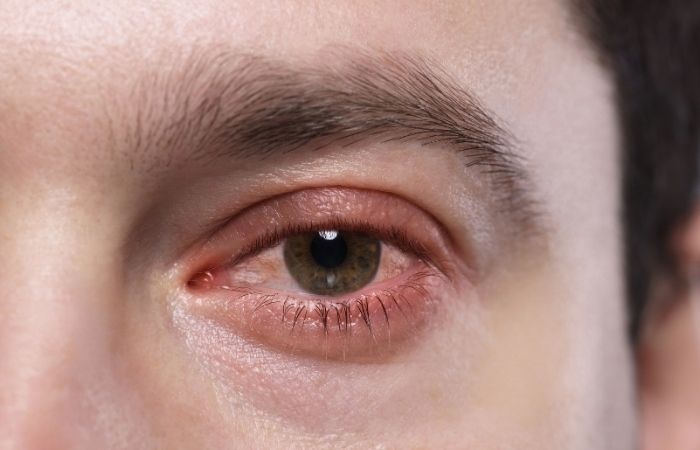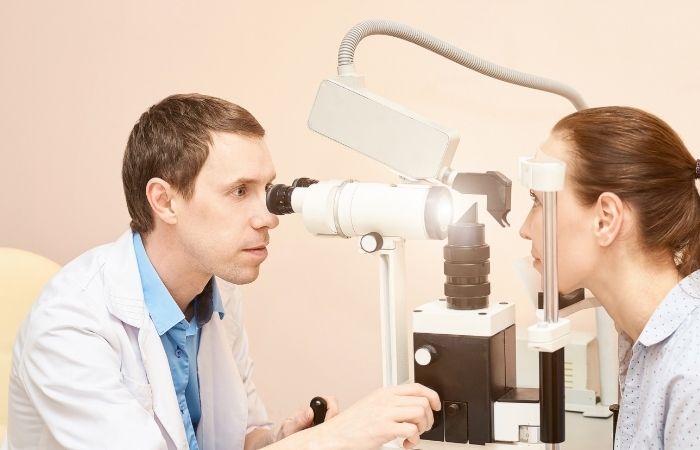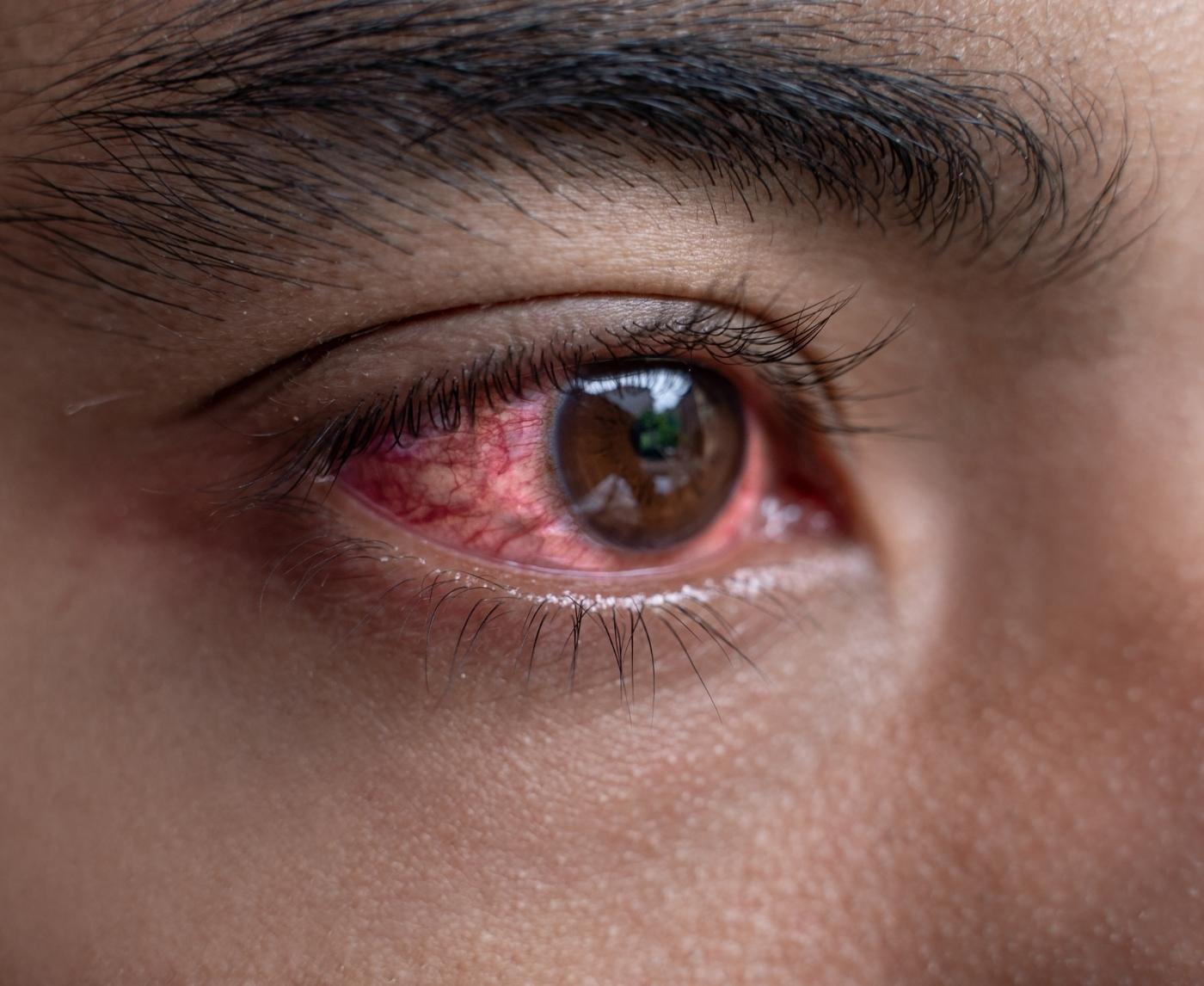Is Oral Sex Safe? Why You Can Still Catch STDs Without Penetration
Quick Answer: STD-related eye infections can mimic pink eye but often include intense discharge, swelling, or crusting, especially after oral sex or contact with semen/vaginal fluids. If only one eye is affected and symptoms start shortly after a hookup, get tested for gonorrhea or chlamydia.
Why STDs Can Show Up in Your Eyes (Yes, Really)
Most people don’t realize that gonorrhea, chlamydia, and even herpes can infect the eyes. It’s called ocular transmission, and it usually happens when genital fluids come into contact with your eye, through hands, towels, or even direct ejaculation. One study found that up to 1% of conjunctivitis cases in sexually active adults may be due to sexually transmitted bacteria, though that number could be higher due to underreporting.
The science is simple: your eyes are mucous membranes, just like your mouth or genitals. That means they’re vulnerable to the same types of bacterial or viral infections, especially if exposed during sex or shortly after. Eye-related STDs aren’t common, but they’re not rare either. And when left untreated, they can lead to permanent damage, including vision loss in severe cases.

People are also reading: How (And Why) Gay Men Can Advocate for Better STD Testing
This Isn’t Just Allergies: Signs You Might Be Dealing with an Eye STD
So how do you know if what you’re dealing with is more than just seasonal irritation or bacterial pink eye? The key is in the context, timing, exposure, and specific symptoms. Here’s what eye-related STDs tend to look and feel like:
Figure 1. Comparison of common eye STD symptoms versus general pink eye causes.
One red flag? If you’ve recently had unprotected oral sex and now have a swollen or crusting eye, it’s worth getting tested. These infections can develop within 1 to 3 days after exposure, fast and furious. Don’t wait for it to “clear up on its own.”
“I Thought It Was Pink Eye. It Was Gonorrhea.”
Marcos, 27, had no idea you could get an STD in the eye. After a casual hookup on a weekend trip, he noticed one of his eyes started burning and leaking sticky discharge. “I figured it was pink eye or allergies. It was just one eye, and I’d slept with the window open,” he told us.
“But it got worse fast, like, I couldn't even open it fully. The white of my eye looked yellow. My roommate freaked out and made me go to urgent care.”
Doctors diagnosed Marcos with gonococcal conjunctivitis, yes, gonorrhea in the eye. A full STD panel confirmed the diagnosis. It cleared with antibiotics, but Marcos admits: “If I hadn’t gone in, I probably would’ve kept treating it like regular pink eye, and I could’ve lost vision.”
Stories like his are rare, but they happen more often than you think. Don’t ignore that crusty eye. Especially not after sex.
How to Actually Test for an Eye STD (Yes, It’s Possible)
You're not the only one who is sitting there and thinking, "Okay, but how would I even test for this?" There is no need to get a separate test for the eye if you have an STD that affects the eye. Testing follows the same steps as testing for genital or oral infections because the bacteria is the same.
A NAAT test (nucleic acid amplification test) is the best way to find out if you have chlamydia or gonorrhea. It looks for bacterial DNA in a urine sample or swab. Some doctors may take a direct eye swab if they think the eyes are involved, but this isn't always necessary if the genital infection is also confirmed.
You can begin by ordering an at-home test that uses urine or vaginal swabs to check for chlamydia and gonorrhea. Your doctor can use these results to help them figure out if the same infection might be affecting your eye.
What If You Already Took Eye Drops and Nothing’s Changed?
This is one of the biggest warning signs that you’re dealing with something more serious than basic pink eye. Most over-the-counter drops target allergens or generic bacteria, not sexually transmitted bacteria like Neisseria gonorrhoeae or Chlamydia trachomatis.
If your symptoms haven’t improved after 48 hours of standard treatment, or if they’ve worsened, you need to get evaluated. In clinic settings, doctors may prescribe stronger antibiotics or injectables for confirmed gonorrhea, especially if it’s attacking mucous membranes like the eye.
Don’t DIY this part. Eye infections related to STDs can cause corneal ulcers, scarring, and even partial blindness if left untreated. Get a test. Bring it to a provider. They’ll take it seriously if you show up informed.
When Did Symptoms Start? Why That Timing Matters
STD-related eye infections tend to develop faster than most realize, sometimes within 1 to 3 days after exposure. That quick onset is a major clue. Regular pink eye from viruses or allergies often follows colds or pollen exposure and develops more slowly.
If you had a hookup over the weekend and your eye flared up by Tuesday, that timeline supports the possibility of sexually transmitted infection. Here’s a visual breakdown of how long symptoms typically take to show up:
Figure 2. Symptom onset timelines for common eye infections, including STD-related conjunctivitis.
Still not sure? Ask yourself this: Did your symptoms appear after sex, but before cold symptoms or seasonal changes? That order matters. And if your symptoms aren’t improving? That’s your cue.
Do You Have to Go to a Clinic for This?
Not always. You can start the process at home by ordering a test for the most likely culprits: gonorrhea and chlamydia. If your test comes back positive, bring that result to a provider to discuss whether your eye symptoms are connected.
If the symptoms are severe, vision changes, intense swelling, pain with light, go in immediately. But if you’re dealing with mild discomfort, crusting, or redness and want to rule out the scary stuff first, at-home testing is a safe and smart first move.
Remember: Testing isn’t a confession. It’s clarity. You deserve to know what’s happening in your body, whether it’s your genitals, throat, or one irritated eyeball. Start here, start safe, and move forward with answers.
What If You Already Have an STD, Can It Spread to the Eye?
Absolutely. If you already have an active genital chlamydia, gonorrhea, or herpes infection, you can accidentally transfer it to your own eye. It’s called auto-inoculation, and it happens more often than you'd think. All it takes is touching yourself, then rubbing your eye before washing your hands.
This is especially common in the first few weeks of infection, before treatment, when bacterial load is highest. That’s why many providers recommend refraining from touching your eyes, sharing towels, or reusing washcloths if you suspect an infection. Gloves aren’t overkill when you’re dealing with a potential mucous membrane transfer.
If you're already treating a genital STD and suddenly develop eye irritation, it could be the same bacteria showing up in a new spot. This is a medical flag, bring it up during your treatment follow-up or testing appointment.

People are also reading: Syphilis Exposure Timeline: What Happens in the First 30 Days
Gender Doesn’t Protect You, But Symptoms Can Vary
Eye-related STDs don’t discriminate by gender. But what does differ is how and when symptoms appear. Men, women, and nonbinary folks may all experience these infections, but shame, delay in care, or misunderstanding of symptoms often plays a role in how soon they seek help.
Men often delay treatment because they expect STDs to show up in the groin, not the eye. This can lead to worse outcomes due to late care. Women and nonbinary people may ignore early redness, especially if it coincides with makeup use, allergies, or hormonal changes.
Regardless of identity, the core signs are the same: one red eye, thick discharge, pain, swelling, or blurred vision, especially after recent sexual activity. Testing and early treatment are your equalizers. Don’t wait for it to get worse.
“It Was Just One Eye. I Didn’t Think It Mattered.”
Sylvie, 22, noticed her left eye was irritated a few days after a night with her ex. “It was itchy, a little crusty in the morning, but I figured it was from crying or sleeping weird,” she shared.
“It wasn’t until it got red and gunky, and I couldn’t wear my contacts, that I started to panic. I still didn’t think it was an STD. Who gets an STD in their eye?”
After doing a home test for chlamydia and gonorrhea and getting a positive result, she brought it to her campus health clinic. The provider confirmed the eye symptoms were related. Oral antibiotics cleared both the genital and ocular infection within 10 days.
“If I hadn’t tested from home first,” Sylvie said, “I would’ve waited another week and probably passed it to my roommate through the bathroom towels.”
Prevention Tips (No Shame, Just Strategy)
Let's be honest: shit happens. Fluids go where they shouldn't. But if you know that eye infections can be spread through sex, you can take small steps to lower your risk without giving up fun or being spontaneous.
This is what helps:
Figure 3. Common-sense prevention tactics for STD-related eye infections.
No shame here. We all make contact in unpredictable ways. The point is to protect your vision, and your partners, by being smart, not scared.
If You’re Still Reading, You’re Already Taking Control
Maybe you’re scared. Maybe you’ve got a mirror in one hand and your phone in the other, wondering if you’re blowing this out of proportion. Maybe someone told you it was “just allergies,” but your gut says otherwise.
That’s why this article exists. Not to freak you out, but to tell you that your symptoms matter. Your confusion is valid. And you’re not the first person to Google “STD eye infection” at 2AM, panicking quietly under the covers.
So before we jump into the FAQs, take this in: the fact that you’re reading this means you give a damn about your health. That’s power. That’s prevention. That’s how you protect your body, your vision, and your peace of mind. Now let’s answer the questions you probably didn’t want to ask out loud.
FAQs
1. Can you really get an STD in your eye?
Yes, and it surprises a lot of people. Fluids like semen or vaginal secretions can carry bacteria like gonorrhea or chlamydia, and if they make contact with your eye (directly or via hands), that’s enough to spark an infection. It’s called “ocular transmission,” and it’s real. Rare? Kind of. But real? Absolutely.
2. Wait, how would I even know if it’s from sex?
Think about the timing. Did the eye thing show up a day or two after a hookup? Especially after oral sex or if things got a little, let’s say...fluid? If it’s just one eye, feels sore, and there’s yellow-green goop? That’s your signal. Pink eye usually hits both eyes and isn’t connected to sexual activity.
3. What does an eye STD actually feel like?
Uncomfortable as hell. Redness, swelling, burning, maybe a gritty feeling like sand under your eyelid. A lot of folks describe thick crusty discharge that seals the eye shut in the morning. If you’ve got that plus a recent sexual encounter, don’t shrug it off, it’s probably not from your allergies.
4. Do I need to stick a swab in my eye to test for this?
Nope. You don’t have to poke your eyeball. A standard STD home test for chlamydia or gonorrhea (via urine or vaginal swab) can give you the answers you need. If you test positive, your doctor will know the eye symptoms are probably related, even if they don’t swab your eye directly.
5. What if I already used eye drops and nothing’s changing?
Then it’s time to look deeper. STD-related infections usually won’t respond to standard pink eye drops from the drugstore. If the redness and discharge stick around or get worse after 48 hours, that’s a red flag. You're not overreacting, you're being smart.
6. Can I spread this to someone else?
Yeah, through shared towels, pillowcases, or even fingers. If you’ve got eye discharge and an untreated STD, skip the communal linens. And wash your damn hands. If it’s a partner you were with recently, give them a heads-up, they might be asymptomatic but contagious.
7. Is this the same as herpes in the eye?
Not exactly, but similar in vibe. Herpes eye infections come from HSV-1 or HSV-2 and usually feel more painful or cause blurry vision. They’re rarer than gonorrhea or chlamydia eye cases, but when they hit, they hit hard. They need antiviral meds, not antibiotics, so testing is crucial.
8. What if I already tested positive for an STD, should I worry about my eyes too?
If you’ve got a confirmed STD and now your eye’s freaking out? Yeah, bring it up. You could be dealing with “auto-inoculation,” which is just a fancy term for accidentally spreading bacteria from your genitals to your eyes (via your own hands). Tell your doctor everything. No shame, just facts.
9. Do I need to go to a clinic or can I handle this from home?
You can absolutely start from home. Get a discreet combo test kit and check for the most likely infections. If it’s positive, or if symptoms get worse, you’ll need a provider to prescribe treatment, but you won’t have to sit in the clinic wondering what’s wrong. You’ll walk in with info.
10. Should I be embarrassed to bring this up with a doctor?
Not even a little. Eye STDs aren’t as weird as they sound. Doctors have seen everything. If you’re honest and bring test results, they’ll take you seriously. You deserve care without judgment. Period.
Call the Signs What They Are, And Get Answers
It’s easy to dismiss an eye issue as “just pink eye.” But if the timing feels suspicious, the discharge is intense, and you’ve had recent sexual contact, it’s time to take it seriously. Fast treatment means faster healing, and less risk of long-term eye damage.
Don’t sit in confusion. Don’t let shame keep you from clarity. Whether it’s your first scare or your fifth, we’ve got your back. Test discreetly, act confidently, and protect your health like it matters, because it does.
Order your Combo STD Home Test Kit here, and get results you can act on.
How We Sourced This Article: We combined current guidance from the CDC, peer-reviewed studies, and real-world stories to help you understand the difference between pink eye and an STD. Around fifteen external sources were used during research, but only the most reader-relevant are listed below. All links were verified and open in a new tab so you can explore more without losing your place.
Sources
1. Can You Get Chlamydia in Your Eye? – Healthline
3. Sex, STDs, and Eye Health – American Academy of Ophthalmology
4. Bacterial Eye Infections Associated with Sexual Transmission Infections: A Review – PubMed
Dr. F. David, MD is a board-certified infectious disease specialist focused on STI prevention, diagnosis, and treatment. He blends clinical precision with a no-nonsense, sex-positive approach and is committed to expanding access for readers in both urban and off-grid settings.
Reviewed by: L. Nguyen, PA-C | Last medically reviewed: September 2025
This article is for informational purposes and does not replace medical advice.







